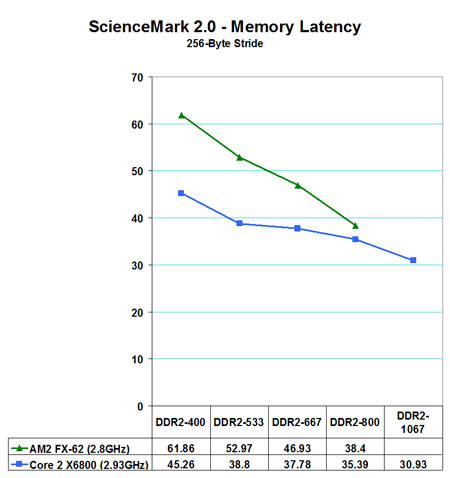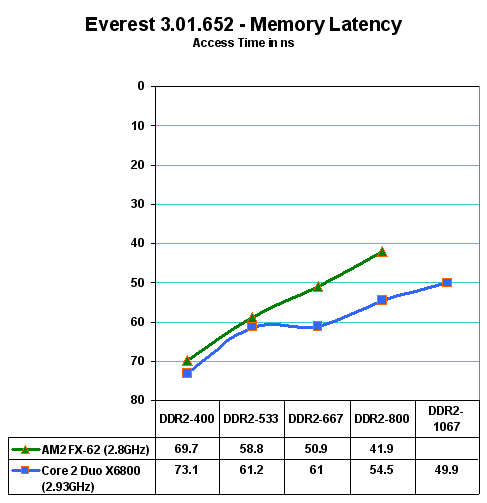A Closer Look at Latency and Scaling
As was explained in the Core 2 Duo launch review, Core 2 Duo has not physically added a memory controller on the processor. The memory controller is still part of the motherboard chipset that drives Core 2 Duo. Intel added features that perform intelligent look-aheads on the memory controller to behave like lower latency. As you saw on pages 2 and 3, ScienceMark 2.0 shows the "intelligent look-aheads" in Core 2 Duo to be extremely effective, with Core 2 Duo memory now exhibiting lower apparent latency than AM2. However, not all latency benchmarks show the same results. Everest from Lavalys shows latency improvements in the new CPU revisions, but it shows Latency more as we would expect in evaluating Conroe. For that reason, our detailed benchmarks for latency will use both Everest 1.51.195, which fully supports the Core 2 Duo processor, and ScienceMark 2.0.
Latency, or how fast memory is accessed, is not a static measurement. It varies with memory speed and generally improves (goes down) as memory speed increases. To better understand what is happening with memory accesses we first looked at Sciencemark 2.0 Latency on both AM2 and Conroe.

ScienceMark shows Conroe Latency with a 45ns to 61ns lead at DDR2-400. Latency continues to decrease as memory speed increases with Core 2 Duo, reaching a value of about 30ns at DDR2-1067. The Trend line for AM2 is steeper than Core 2 Duo, increasing at a rapid rate until latency is virtually the same at DDR2-800.
It is very interesting that ScienceMark shows lower latency on Core 2 Duo than AM2, since we all know the on-chip AM2 controller has to be faster. We thought perhaps it was because all of the tested memory accesses could be contained in the shared 4MB cache of Core 2 Duo, but Alex Goodrich,one of the authors of ScienceMark, states that Version 2 is designed to test up to 16MB of memory, forseeing the day of larger caches. In addition he states the Core 2 duo prefetcher is clever enough to pick up all the patterns ScienceMark uses to "fool" hardware prefetchers. ScienceMark plans a revision with an algoritm that is harder to fool, but Alex commented that Conroe fooling their benchmark was "in itself a great indicator of performance".

Everest uses a different algorithm for measuring Latency, and it shows the on-chip AM2 DDR2 controller in the lead at all memory speeds, with Latency almost the same at the Core 2 Duo memory speed range of DDR2-400 to DDR2-533. However, the Everest trend lines are similar to those in ScienceMark, in that AM2 latency improves at a steeper rate than Core 2 Duo as memory speed increases.
The point to the Latency discussion is that, as expected, AMD has much more opportunity for performance improvement with memory speed increases in AM2. Intel will eventually reach the point, if the lines were extended, where they would have to move to an on-chip memory controller to further improve latency. This is not to take anything away from Intel's intelligent design on Core 2 Duo. They have found a solution that fixes a performance issue without requiring an on-chip controller - for now.
As was explained in the Core 2 Duo launch review, Core 2 Duo has not physically added a memory controller on the processor. The memory controller is still part of the motherboard chipset that drives Core 2 Duo. Intel added features that perform intelligent look-aheads on the memory controller to behave like lower latency. As you saw on pages 2 and 3, ScienceMark 2.0 shows the "intelligent look-aheads" in Core 2 Duo to be extremely effective, with Core 2 Duo memory now exhibiting lower apparent latency than AM2. However, not all latency benchmarks show the same results. Everest from Lavalys shows latency improvements in the new CPU revisions, but it shows Latency more as we would expect in evaluating Conroe. For that reason, our detailed benchmarks for latency will use both Everest 1.51.195, which fully supports the Core 2 Duo processor, and ScienceMark 2.0.
Latency, or how fast memory is accessed, is not a static measurement. It varies with memory speed and generally improves (goes down) as memory speed increases. To better understand what is happening with memory accesses we first looked at Sciencemark 2.0 Latency on both AM2 and Conroe.

ScienceMark shows Conroe Latency with a 45ns to 61ns lead at DDR2-400. Latency continues to decrease as memory speed increases with Core 2 Duo, reaching a value of about 30ns at DDR2-1067. The Trend line for AM2 is steeper than Core 2 Duo, increasing at a rapid rate until latency is virtually the same at DDR2-800.
It is very interesting that ScienceMark shows lower latency on Core 2 Duo than AM2, since we all know the on-chip AM2 controller has to be faster. We thought perhaps it was because all of the tested memory accesses could be contained in the shared 4MB cache of Core 2 Duo, but Alex Goodrich,one of the authors of ScienceMark, states that Version 2 is designed to test up to 16MB of memory, forseeing the day of larger caches. In addition he states the Core 2 duo prefetcher is clever enough to pick up all the patterns ScienceMark uses to "fool" hardware prefetchers. ScienceMark plans a revision with an algoritm that is harder to fool, but Alex commented that Conroe fooling their benchmark was "in itself a great indicator of performance".

Everest uses a different algorithm for measuring Latency, and it shows the on-chip AM2 DDR2 controller in the lead at all memory speeds, with Latency almost the same at the Core 2 Duo memory speed range of DDR2-400 to DDR2-533. However, the Everest trend lines are similar to those in ScienceMark, in that AM2 latency improves at a steeper rate than Core 2 Duo as memory speed increases.
The point to the Latency discussion is that, as expected, AMD has much more opportunity for performance improvement with memory speed increases in AM2. Intel will eventually reach the point, if the lines were extended, where they would have to move to an on-chip memory controller to further improve latency. This is not to take anything away from Intel's intelligent design on Core 2 Duo. They have found a solution that fixes a performance issue without requiring an on-chip controller - for now.










118 Comments
View All Comments
sld - Tuesday, July 25, 2006 - link
Yes I second the importance of a 32M run, because I want to know how Core 2 Duo does when the dataset does not fit into the L2 cache. The Intel fanboys at xtremesystems are annoying me with their whoops of glee over the 1M and 2M results.The performance difference in games and superpi is large enough to be termed anomalous, simply because superpi is a feel-happy benchmark.
Calin - Tuesday, July 25, 2006 - link
I've had the same issue on understanding the graphic - but I think it is much better now (top representing better performance, with the scale inverted)Anyway, great article!
As for the increases in cache helping AMD processors, I guess not - considering the small difference from 512k to 1M.
mattsaccount - Tuesday, July 25, 2006 - link
Never mind, I'm tired :)goinginstyle - Tuesday, July 25, 2006 - link
Page 7 is going to upset a lot of AMD fans.Page 9 index description needs to be "conclusion".
Great article and would love to see this comparison with the E6600 and E6300 CPUs against the competing AMD cpus. A lot of us will be buying these two processors and probably plain DDR2800.
OcHungry - Tuesday, July 25, 2006 - link
Can I ask you what memory timings you used?Since you have stated that memory speed does not affect conroe, would it be fair to assess that you used tightest timings for AM2?
If not: why?
About what page is going to make AMD users upset or hate the page, I totally disagree with you. You actually brought some lights to the whole scheme of things, unintentionally and unknowingly. You have helped to prove that Conroe will only be a mere 1 or 2% faster than AM2, which is not noticeable in real life situation. Conroe is only faster in Spi- But again, AMD beats Intel in memory bandwidth by a great margin. Memory bandwidth is much more important than SPI in terms of game and general cpu task(s). I will prove to everyone, that AMD is just as fast as conroe and post my reasoning in the cpu section, as soon as I have analyzed your benchmark data and made my calculations. But I need to know what memory timings you did use thu. A screenshot of timings would be great.
Again, thank you for this review that helped us open our eyes and see things in a better perspective.
Gary Key - Tuesday, July 25, 2006 - link
Wes replied earlier in the comments section but the settings are now posted on page 4 of the review.
goinginstyle - Tuesday, July 25, 2006 - link
Caluclations? I would like to see your benchmarks on actual hardware and not some scribbling on your Happy Meal napkin. I can caluclate that you are an idiot but really do not have the time to do it since I have a real life.
zsdersw - Tuesday, July 25, 2006 - link
1 or 2% faster? Please share with the rest of us what you're smoking.
Conroe is significantly faster on almost all fronts... in spite of having lower memory bandwidth.
Calin - Wednesday, July 26, 2006 - link
I suggest you to use a tractor and two trailers - one for persons and one for cargo. Even if you won't go faster than people with cars, you will have a huge bandwidth (persons and cargo bandwidth).If you buy your processor for bandwidth, choose whatever you want. If you buy it for speed, buy based on actual performance
bob661 - Tuesday, July 25, 2006 - link
I thought you didn't care about this stuff?